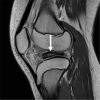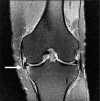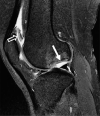Magnetic resonance imaging of the knee
- PMID: 33101555
- PMCID: PMC7571514
- DOI: 10.5114/pjr.2020.99415
Magnetic resonance imaging of the knee
Abstract
Knee pain is frequently seen in patients of all ages, with a wide range of possible aetiologies. Magnetic resonance imaging (MRI) of the knee is a common diagnostic examination performed for detecting and characterising acute and chronic internal derangement injuries of the knee and helps guide patient management. This article reviews the current clinical practice of MRI evaluation and interpretation of meniscal, ligamentous, cartilaginous, and synovial disorders within the knee that are commonly encountered.
Keywords: cartilage; knee; ligament; magnetic resonance imaging; meniscus; patellar instability.
Copyright © Polish Medical Society of Radiology 2020.
Conflict of interest statement
The authors report no conflict of interest.
Figures








































References
-
- Qi ZH, Li CF, Li ZF, et al. . Preliminary study of 3T 1H MR spectroscopy in bone and soft tissue tumors. Chin Med J 2009; 122: 39-43. - PubMed
-
- Chhabra A, Lee PP, Bizzell C, et al. . 3 Tesla MR neurography–technique, interpretation, and pitfalls. Skeletal Radiol 2011; 40: 1249-1260. - PubMed
-
- Miller JD, Nazarian S, Halperin HR. Implantable Electronic Cardiac Devices and Compatibility With Magnetic Resonance Imaging. J Am Coll Cardiol 2016; 68: 1590-1598. - PubMed
-
- American College of Radiology. ACR–SPR–SSR practice parameter for the performance and interpretation of magnetic resonance imaging (MRI) of the knee. Available from: https://www.acr.org/-/media/ACR/Files/Practice-Parameters/MR-Knee.pdf. - PubMed
Publication types
LinkOut - more resources
Full Text Sources
